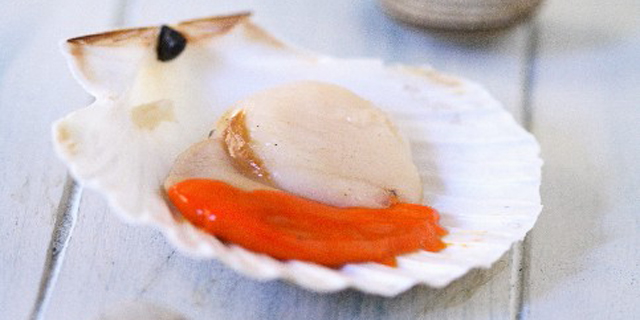Scallops, mollusks with a fan-shaped ribbed or smooth shell, were once described to me as Poseidon’s truffles, and I think it’s the perfect way to describe the sweet, tender taste of a scallop.
Seafood lovers appreciate scallops pan-seared and quickly popped in the mouth, as a main ingredient in paella and even baked in parmesan. Scallops are one of those foods that are fairly easy to cook, even for those that can’t tell an oven mitt from a catcher’s mitt. The key is in picking out the perfect scallops for the dish you’re making.
“‘Quantity is enemy of quality,’ my grandfather used to say,” explained Joe Bomster of Stonington Seafood Harvesters about scallops.
Bomster and his family have been fishing for scallops for decades; he and his brothers were just kids when they started. Today, Bomster scallops are popular up and down the East Coast for their all-natural flavor, captured by freezing the scallops on the boat in five minutes or less.
“The only way you’re going to get a fresher scallop is if you’re on the boat when it’s caught,” Bomster said.
Read on for Bomster’s tips on picking out the perfect scallop…
[ pagebreak ]First, you should always ask when the scallops came in. This is especially important if you are buying non-frozen scallops. The fishing boats are often out for 10 to 12 days at time. You want to know when the fishermen caught the scallops in relation to when the boats finished their trip. This helps gauge the freshness of the scallops.
Next, be sure to ask how the scallops were preserved. There are several different methods, including the Bomster method of freezing them quickly on the boat. Scallops preserved without the use of chemicals are dry packed, or sometimes vacuumed sealed. Wet scallops, refer to a type of packing where the scallops are processed using water or a chemical called sodium tripolyphosphate, a common chemical in seafood and meats. Most stores, however, sell scallops by the pound and processing scallops with water or sodium tripolyphosphate adds weight. Buyer beware: you may not be getting the amount of scallops you think you are getting.
While the Bomster family fishes sea scallops, the scallops that live on the ocean floor about 25 to 200 meters in depth with a smooth exterior shell, there are several other types of scallops. Sea scallops give you that crusty outer shell when seared, but bay scallops live in shallow water and have a rippled exterior shell. Often farm raised, bay scallops can be a bit more delicate with a sweeter flavor but are not ideal for pan searing. Diver scallops are for those that want their seafood to do its part for the environment. These scallops are harvested by divers and, according to environmental groups such as Seafood Watch, do the least damage to the environment. Diver scallops tend to be larger, as divers usually harvest more adult scallops.
Now, that you know how to pick out the perfect scallops try cooking them at home.
Next, Ivy Stark of Dos Caminos shares her recipe for seared diver scallops with passion fruit salsa and Erik Ramirez of Raymi shares a recipe for parmesan baked scallops…
[ pagebreak ]
Seared Diver Scallops with Passion Fruit Salsa
- 3 tablespoons vegetable oil
- 2 red bell peppers finely diced
- 6 jalapeños seeded and finely diced
- 1 1-inch piece of ginger finely minced
- 1/2 pineapple peeled and finely diced
- 3 cups passion fruit puree
- 2 qts. Pineapple juice
- 1 cup jasmine rice, soaked for 20 minutes
- 1 can coconut milk
- 1 4-inch stick canela
- 4 U-10 Scallops
- 4 parmesan crust discs
- 1 1/2 ounces butter sauce
- 1 teaspoon fresh chives
- 1 lime wedge (optional)
- 1/2 cups butter
- 1/2 quart panco
- 1 quart parmesan
- 250 grams white wine
- 60 grams shallots




![Making Mealtime Matter with La Familia: Easy Sofrito [Video]](https://thelatinkitchen.com/wp-content/uploads/2015/10/sofrito-shutterstock__0-500x383.jpg)
![Easy Latin Smoothies: Goji Berry Smoothie [Video]](https://thelatinkitchen.com/wp-content/uploads/2015/12/goji_berry-shutterstock_-500x383.jpg)
















![Fun and Fast Recipes: Fiesta Cabbage Salad [Video]](https://thelatinkitchen.com/wp-content/uploads/2015/11/fiesta_cabbage_slaw-shutterstock_-500x383.jpg)









